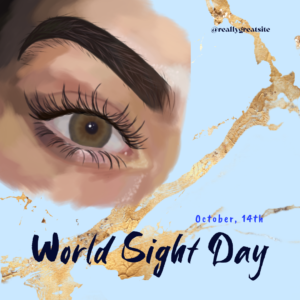World Sight Day is a significant global event observed annually on the second Thursday of October. – Eye Health It is a day dedicated to raising awareness about eye health and advocating for better access to eye care services worldwide. This day aims to bring attention to the issues of preventable blindness and vision impairment, which affect millions of people across the globe.
The Importance of World Sight Day
 World Sight Day was initiated by the World Health Organization (WHO) and the International Agency for the Prevention of Blindness (IAPB) in 2000. It serves as an opportunity to highlight the importance of vision health and the need for collective action to reduce the prevalence of avoidable vision loss. Around 2.7 billion people worldwide suffer from unaddressed poor vision, making it one of the most significant public health challenges. Many of these conditions are preventable or treatable if proper care is provided.
World Sight Day was initiated by the World Health Organization (WHO) and the International Agency for the Prevention of Blindness (IAPB) in 2000. It serves as an opportunity to highlight the importance of vision health and the need for collective action to reduce the prevalence of avoidable vision loss. Around 2.7 billion people worldwide suffer from unaddressed poor vision, making it one of the most significant public health challenges. Many of these conditions are preventable or treatable if proper care is provided.
Each year, the event focuses on a specific theme related to eye health. Themes in the past have centered on issues such as access to eye care, improving access to cataract surgeries, and the impact of digital screen time on vision health.
Raising Awareness about Preventable Blindness and Vision Impairment
Many causes of vision impairment and blindness can be avoided with timely medical intervention. The main contributors to avoidable vision loss include:
-
Cataracts: A clouding of the eye’s natural lens, often associated with aging, is one of the leading causes of blindness. Surgery to remove cataracts is a simple and cost-effective procedure that can restore sight.
-
Uncorrected Refractive Errors: Conditions like nearsightedness, farsightedness, and astigmatism can be easily corrected with glasses, yet millions of people lack access to proper vision correction.
-
Glaucoma: A group of eye conditions that damage the optic nerve and can lead to permanent blindness. Early detection and treatment can prevent vision loss.
-
Age-Related Macular Degeneration (AMD): A condition that affects the macula, leading to loss of central vision, particularly in older adults. Early intervention can help manage AMD.
-
Diabetic Retinopathy: Caused by damage to the blood vessels in the retina due to diabetes, it can lead to blindness if left untreated. Regular eye screenings for people with diabetes can prevent vision loss.
-
Childhood Blindness: Many children across the world suffer from blindness due to conditions like vitamin A deficiency, cataracts, or corneal scarring caused by infections. Early treatment is essential to prevent long-term disability.
Key Goals of World Sight Day
-
Promoting Access to Eye Care: Ensuring that everyone, regardless of their geographic location or economic status, has access to affordable eye care and treatment.
-
Encouraging Early Diagnosis and Treatment: Promoting regular eye checkups to catch eye conditions early, particularly for those at higher risk, such as older adults and individuals with diabetes.
-
Educating the Public: Raising awareness about the importance of eye health, proper eye care, and how lifestyle choices—such as nutrition, exercise, and reducing screen time—can protect vision.
-
Advocating for Policy Change: Pushing for government policies and healthcare initiatives that increase funding for eye care services and support vision health research.
-
Raising Funds for Eye Health Programs: Many organizations and nonprofits use World Sight Day to fundraise for initiatives aimed at providing eye care services to underserved communities, especially in developing countries.
How to Get Involved in World Sight Day
-
Volunteer or Donate: Many organizations, such as the IAPB, offer opportunities to get involved by volunteering or donating to support their eye health initiatives.
-
Spread Awareness: Use social media to share information about eye health and the importance of regular eye exams. Use the hashtag #WorldSightDay to join the conversation.
-
Organize or Participate in Events: Some cities and communities organize events, such as free eye screenings, health talks, or fundraising activities. Participating in or organizing these events can help spread the message.
-
Advocate for Policy Change: Contacting local representatives and advocating for better healthcare policies related to vision care can help make eye health a priority in your community.
 The Role of Technology in Eye Health
The Role of Technology in Eye Health
With advancements in medical technology, there are more ways to treat and diagnose eye conditions than ever before. Telemedicine, for example, is allowing people in remote areas to receive consultations and diagnoses from specialists who may not be available locally. Additionally, innovative treatments and surgical procedures are helping improve the quality of life for people with vision impairments.
The Road Ahead
While progress has been made in addressing global eye health, there is still much to be done. According to the World Health Organization, at least 1 billion people around the world suffer from preventable or unaddressed vision impairment. The goal for the future is to ensure that everyone, no matter where they live or their financial situation, can access quality eye care and live a life free from preventable blindness.
As we celebrate World Sight Day, let’s take a moment to reflect on the importance of our vision, spread awareness about the need for improved eye care, and take steps toward a future where no one has to suffer from avoidable blindness.
Conclusion
World Sight Day is a powerful reminder that eye health matters and that together, we can create a world where no one has to live with preventable vision loss. Whether by raising awareness, supporting eye health programs, or advocating for policy changes, each of us can play a role in improving global eye health. Let’s work together to ensure that everyone, regardless of where they live or their circumstances, has the opportunity to see the world clearly.
More information :-https://youtu.be/q5N3gcyic8A?si=5a3iMbwR3ADxVaTb
https://www.iapb.world/world_sight_day
More information :- World Smile Day
